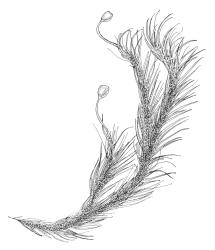Plants minute to robust, often glossy, saxicolous. Stems simple or forking repeatedly, wiry or soft. Leaves lanceolate, subulate, or linear, usually with a distinct base and often ± shouldered, plane, mostly entire or denticulate; laminal cells long- or short-rectangular or quadrate, firm- to thick-walled, not porose, smooth; alar cells absent or well-differentiated. Costa single, narrow or broad below, mostly filling the upper leaf, in cross-section usually with a differentiated median layer of guide cells.
Dioicous or autoicous. Setae elongate or short; capsules mostly exserted, symmetric, dark, often turbinate or urceolate when dry, usually thick-walled, often with an elongate and persistent columella; mouth transverse; exothecial cells usually uniformly thick-walled; stomata superficial, few at base of capsule or sometimes apparently absent; annulus not differentiated; operculum mostly conic-rostrate, smooth, often systylious. Peristome haplolepideous, well-developed or absent, with 16, lanceolate, mostly red teeth, the outer surface composed of strongly thickened and usually smooth (but sometimes appearing warty in N.Z. species due to presence of a preperistome) plates and with well-developed transverse walls, lacking a median zigzag line; preperistome absent or occasionally present (in Blindia). Calyptra cucullate and smooth. Spores spherical, smooth or papillose, often green.
The family is placed within the subclass Dicranidae, order Grimmiales by Goffinet et al. (2009). The Seligeriaceae are considered to include six (including Notothamia) genera of predominantly temperate to cool-temperate distribution. Blindia and Seligeria are the largest genera in the family.
The genus Notothamia was recently erected by Ochyra & Seppelt (2011) to accommodate the rare Tasmanian taxon originally described as Blindia ferruginea Mitt. Only a few collections of N. ferruginea (Mitt.) Ochyra & Seppelt, from Tasmania and Victoria, have been verified. Its sporophyte morphology clearly suggests that it is correctly placed in the Seligeriaceae, although the leaf cells are aberrant in this family (as noted by Bartlett & Vitt 1986). This species is misplaced in Blindia and the genus Notothamia is worthy of recognition. The two Tasmanian collections verified are from 4000 and 4300 feet (1220 and 1311 m) elevation, while the one Victorian collection was from sandstone at an unspecified elevation in mountains of the Grampians National Park. Notothamia ferruginea could reasonably be expected in alpine areas of N.Z., where it might be confused, if sterile, with a Dicranoweisia or a costate Andreaea.
| 1 | Plants medium-sized to robust, with elongate stems; leaves rarely less than 3 mm, mostly >5 mm; mid laminal cells elongate-rectangular to linear (rarely subquadrate); alar cells variably differentiated, usually coloured and inflated; spores c. 18–45 µm in N.Z. species; on non-calcareous rock, gravel, or silt (B. magellanica grows occasionally on limestone), mostly aquatic or subaquatic | Blindia |
| 1' | Plants extremely small, with stems less than 3 mm in N.Z. species; leaves <2.2 mm; mid laminal cells quadrate to short-rectangular; alar cells not differentiated; spores smaller (c. 8–15 µm in N.Z. species); on calcareous or cation-rich rock, not aquatic (in N.Z. species) | Seligeria |
| Category | Number |
|---|---|
| Indigenous (Endemic) | 4 |
| Indigenous (Non-endemic) | 5 |
| Total | 9 |




